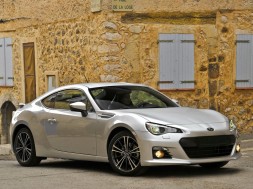The Subaru BRZ, an all-new sports car, has been very carefully designed to be a winner by Toyota and Subaru engineers and designers, working largely together. There was a clear purpose in mind: make an affordable sports car without luxury add-ons or mega horsepower, but that is still state of the art when it comes to efficiency in the powertrain and chassis. It took a clean sheet of paper to do that.
The Subaru BRZ is rear-wheel drive, and its rear-wheel-drive layout is a key aspect to what makes it great. The BRZ a 2+2 coupe, with jump seats in the rear for children or stuff like gym bags.
The engine is a new 2.0-liter with the latest direct port injection, making 200 horsepower normally aspirated. The standard 6-speed manual gearbox is way fun, carefully designed like the rest of the car to be that way. There’s an optional paddle-shifting 6-speed automatic, if you don’t want to deal with a clutch pedal. It’s the only option for the car, beyond two models, Premium and Limited.
The suspension is tight; it negates the bumps and hugs the road, and doesn’t transmit anything harsh or jarring. The handling is more flick-able than any sports car out there, including the Mazda MX-5 (although not counting the nearly identical Scion FR-S because anything we say about the BRZ is also true for the FR-S). Between the suspension, turn-in from a quick steering ratio, and manual gearbox, the BRZ offers almost as much pure sports car fun as the MX-5, as long as you don’t need the wind in your hair and no back seats to feel like you’re driving a sports car.
Subaru boasts about the low center of gravity making the BRZ special, and rightly so. The center of gravity is 1.9 inches lower than that of the Porsche Cayman. The whole car, including the new engine, was designed with that in mind. A low center of gravity, along with balanced front-rear weight distribution, is what makes that excellent handling.
We got good seat time on some of our favorite twisty roads, and had a ball. Later we drove the BRZ on Oregon back roads at an event called Run to the Sun, hosted by the Northwest Automotive Press Association. We drove as aggressively as we dared, with no worries about losing control, also thanks to the standard non-intrusive stability control that has five levels, including one for track driving. The BRZ will be a blast at track days or autocross events. In fact, the interior was designed with room to carry four tires, with the seatbacks of the rear jump seats folded flat. The standard summer performance tires are fine on the track, but some track-day drivers and most autocross drivers go for stickier rubber so they’ll be able to drive to the event on the street tires and change over to the race tires for the event.
Rear-wheel drive is a modern first for Subaru, a company that’s been totally all-wheel drive almost forever. With no drivetrain to the front wheels, the engine could be placed farther rearward to achieve better balance; the engine is 9.5 inches farther back than the 2.0-liter engine in the Subaru Impreza. And the engines are slightly different at the intake manifold and oil pan, so the BRZ engine could also be mounted 2.4 inches lower than the Impreza’s. The BRZ’s light weight of 2762 pounds, using high-tensile steel in the frame with an aluminum hood, adds to the car’s agility.
The styling doesn’t turn heads, unless maybe the BRZ is a flashy color, for example copper like the Scion FR-S comes in. If the BRZ’s lines resemble any other car, it might be the same-sized Nissan 370Z, or the Mazda RX-8, a car that might be the best comparable. The BRZ is super low, with a roof height of only 50.6 inches, or.8 inches lower than that of the Porsche Cayman. From the side, its distinction is in the humps on the fenders harboring 17-inch wheels and tires. The roof has a wide groove, and that adds distinction, and the sideview mirrors are sharpened, which is also neat; but there are some cheap plastic bits on the sides and nose of the car.
The interior is tight, simple and comfortable. That’s tight as in design, not lack of space. There’s no apologizing for the fabric seats, which are rugged and stylish with excellent bolstering. Little kids will love the two seats in the back. Navigation is standard and blessedly simple. Alloy pedals and red-stitched leather-wrapped steering wheel and shift knob are cool. We especially liked the tachometer mounted in center that includes a digital readout for speed that’s very easy to read. In fact, the speedometer redundant.
Fuel mileage is good, with the 6-speed manual delivering an EPA-estimated 22 City/30 Highway/25 Combined, and the 6-speed automatic bringing better numbers, 25/34/28 mpg. But that’s on Premium fuel, because of the high compression ratio of the direct port injection engine, so fuel cost isn’t as good as mpg appears.





